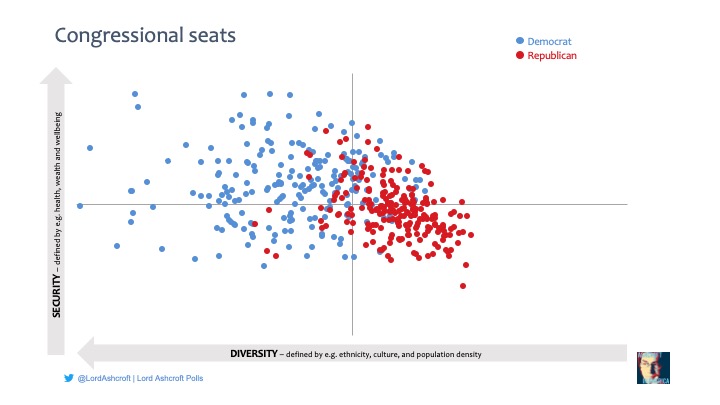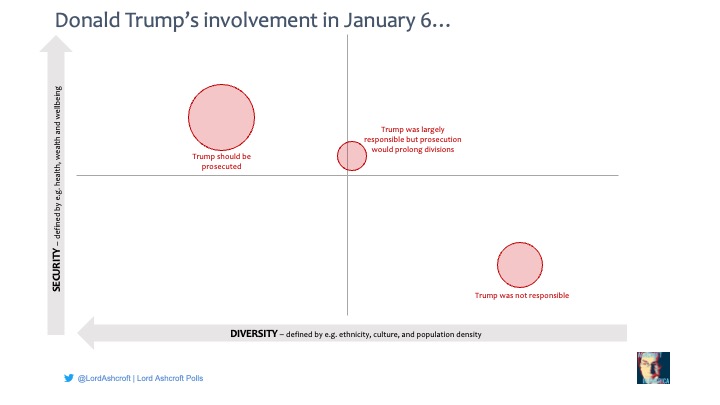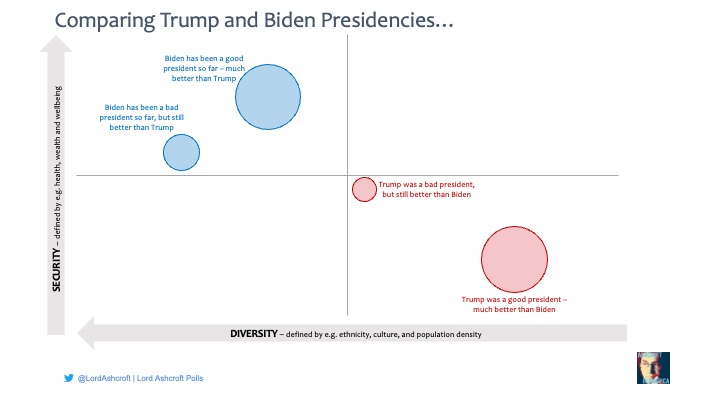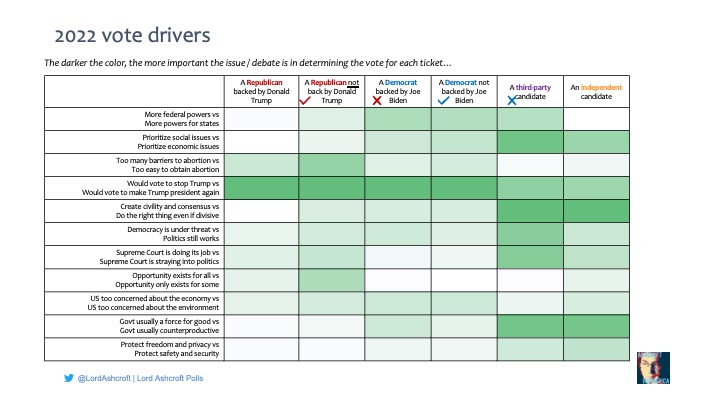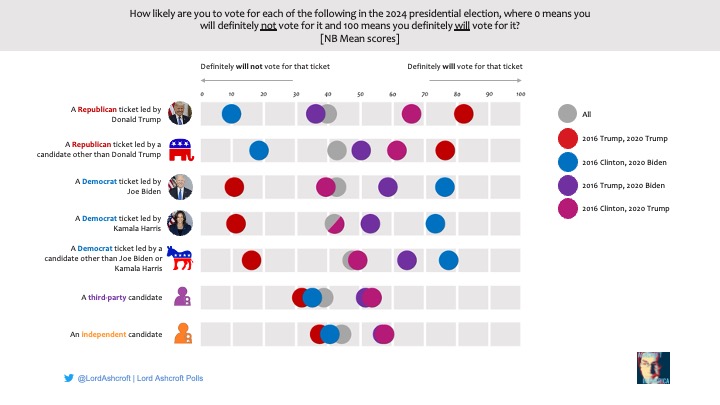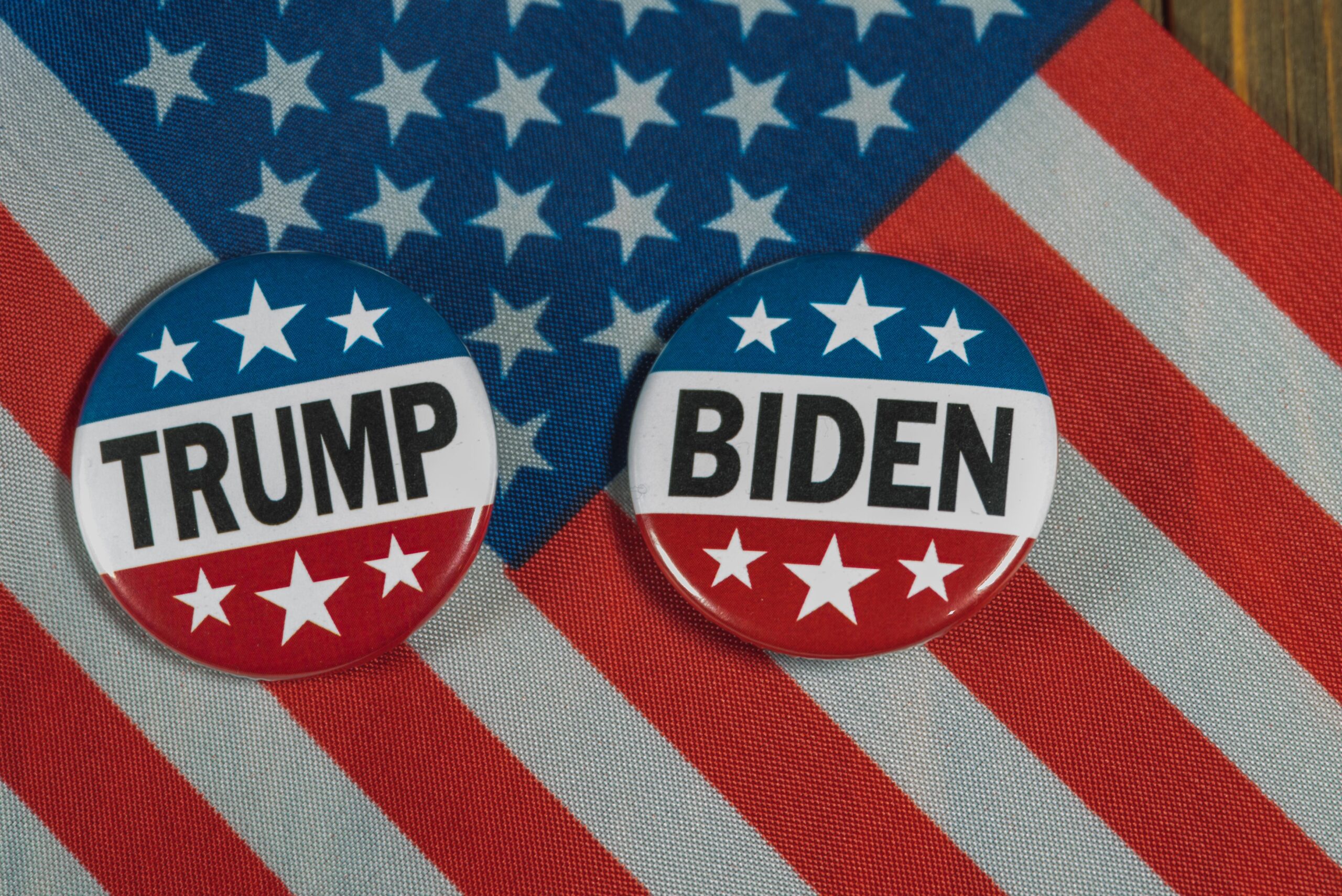
This is the text of my talk at the E2 Summit in Utah, hosted by Senator Mitt Romney and Speaker Paul Ryan
I always feel something of an imposter when speaking to an American audience about their own politics. Rather than sharing that view, I hope you will feel I can bring the objective detachment of the outsider – not least because my analysis is based on a poll of 20,000 Americans, together with focus groups of voters from all walks of life in four crucial states: Pennsylvania, Georgia, Arizona and Florida.
Since last we met the political agenda has moved on, but the forces underlying the divisions that have long driven American politics remain. At our last gathering I introduced a model designed to help understand these forces. Here I will use the same tool to look at the landscape of opinion that underlies the midterm election and the approach to 2024.
Our model maps the electorate according to their security on one hand the diversity of their communities on the other. The vertical axis represents Security, which includes measures like income, house value, education and health: the higher up the axis, the more secure. The horizontal axis represents Diversity, including factors like ethnicity, population density, urbanity and marital status: the further to the left on this axis, the more diverse the community. All of these are derived from census data. This means we have four quadrants of above and below average levels of Security and Diversity onto which we can map people, neighbourhoods, counties, Congressional districts and states.
This is where the 50 states sit on that map, and how they voted in 2020. The Democrats clearly dominate the high-security, high-diversity top-left quadrant, while the Republicans do better in the lower-security, lower-diversity bottom right. It is no coincidence that the battleground states, including those that changed hands in 2020, sit close to the fault line between the two.
Here we see the counties that switched from Trump to Biden at the last election, both on the physical map and in our model. We can see the inroads that the Biden campaign managed to make into territory the Republicans would traditionally have considered their own – the large bubble close to the centre, for example, represents Maricopa County in Phoenix, and we see blue gains creeping into the more prosperous, less diverse top right quadrant of the map. The few Republican gains were confined to the less well-off bottom half of the map.
Overall, we see a continuation of a political and cultural divide that runs through the United States from the top right to the bottom left. But it hasn’t always been this way.
Last time I shared a similar chart showing how the Republican and Democrat votes have evolved over the last 40 years – from the economic divide that dominated politics for most of the last century to the cultural divide we see today. That trend continued in 2020, with the Trump vote edging even further into the bottom right corner of the map. The Republican centre of gravity is now firmly in the bottom right – essentially, rooted in less prosperous rural and small-town America – with the Democrats representing a much more diverse and, in economic terms, increasingly upscale constituency.
Looking forward to November, we can use the same model to map the 435 districts of the House of Representatives. Again, the more urban and diverse the community and the more secure its voters, the more likely the district is to be held by a Democrat. Another striking thing about this map is that liberal districts are further from the centre – less representative of the country as a whole – than conservative ones. And at the extremes of this map we get, well, the extremes.
On the far left, in both senses, we find the 12th District of California and the 14th District of New York, held respectively as you will know by Nancy Pelosi and the formidable AOC. All of which perhaps adds statistical validation to the old adage that all politics is local.
Our polling confirms what the distribution of votes and seats suggests – that conservatives are most prevalent in the less diverse, less secure, Trump-voting bottom right, that liberals tend to be in the opposite corner, and – as I never tire of pointing out – socialists are most likely to be found among those who can afford to think that socialism sounds like a good idea.
It is also worth noting that those who voted for Trump the first time around but switched to Biden in 2020 are most likely to be found squarely in the top right. Despite their demographic position, my polling shows that these voters are closer to the Democrats than the Republicans on most contentious issues, notably including free trade, globalisation, multiculturalism and climate change. What was once solidly Republican territory is now on the heavily contested electoral fault line.
Our polling on the most important issues facing the country – and therefore the concerns that voters will be taking into the midterm elections and beyond – confirms the cost of living to be an issue that dominates many people’s daily lives and transcends all other divisions. Certainly it was the first issue to be raised spontaneously in nearly all our focus groups.
It is not necessarily the case that people in the top left, most liberal quarter of the population are the only ones to care about climate change, race relations or transgender rights. However, it is the case that these voters are more likely to put those things at the top of their priority lists.
Meanwhile, national security and especially immigration and border control are bigger concerns among low-security voters of the conservative bottom right than among the prosperous liberal territory in the opposite corner. We were presented with a perfect vignette of this tension when our Florida focus groups coincided with the Governor’s decision to share some of its migrant population with the good people of Martha’s Vineyard. To a certain extent focus group evidence is necessarily anecdotal, but I must say that indignation at the gesture was hard to come by. One Latino woman in Miami told us that when she heard the news she could not stop laughing. Another participant objected only to spending his tax dollars on a publicity stunt. Later in Phoenix a man of central American descent told us, “I’m kind of for it. If they want to be sanctuary states, let them put their money where their mouth is.”
Some more moderate and liberal participants were aghast, but however controversial the action it certainly highlighted what remains an important concern. No-one thought the border was any less chaotic under President Biden – or more accurately, Vice President Harris – than it had been under President Trump.
Though the issue of women’s rights is more likely to top the agenda for top-left liberals than for other people, there is no doubt that it has taken on a new significance across the board since the overturning of Roe v. Wade in June. We’ve all seen polls showing majority support for abortion rights, and that the issue is galvanising Democrats and pushing moderate voters – not just women – towards pro-choice candidates. My poll found relatively few absolutists on either side: a majority thought it should either be mostly legal with some restrictions, or mostly illegal with some exceptions.
A majority overall, including nearly 4 in 10 Republicans, think laws on the issue should be made at a federal level and apply across all states. But since it is hard to see any such law finding its way through both Houses, past the filibuster and onto the president’s desk, we can obviously expect it to be more salient in state-wide races across the country. As with covid, the implications of Roe v. Wade have given many voters a new appreciation of the power held by their local politicians.
Some moderate voters in our groups told us they would look more carefully at candidates’ credentials on the issue, while Republicans who welcomed the new ruling were worried about what they saw as the extreme restrictions proposed by some red states. While building a solid majority on the Court has long been a campaign theme for conservatives, they are perhaps now, as one of our focus group participants astutely observed, “the dog who caught the car.” I don’t want to downplay the deeply held convictions at stake in this debate, or indeed to defend Roe, which was clearly a flawed and troublesome ruling, as set out in Justice Alito’s fascinating opinion. But in electoral terms it may turn out to be another lesson that in politics as in life it is as well to be careful what you wish for.
It is no surprise to see how attitudes divide on some of the current questions of culture and identity. Those who say adhere to the doctrines of structural racism and white privilege, who think the government should prioritise tackling hate speech over standing up for free speech, and who believe that anyone who identifies as a woman is a woman are naturally to be found in the liberal top-left quadrant, while those who resist those ideas are most heavily concentrated in the Trump-voting bottom right.
The spread of attitudes to economic issues is perhaps more surprising. It is striking that support for welfare benefits, more government spending and a higher minimum wage are most concentrated in the more prosperous top-left. Scepticism about all these things is most likely to be found among those who might be expected to benefit from them. Not only are political views are determined more by culture than economics, but people’s views about economic questions are themselves largely determined by their cultural outlook.
Similarly, we see that people in the less prosperous bottom-right quadrant are the most likely to think that people expect too much from the government, with their opposite numbers in liberal land feeling that government should do more. The idea that if you work hard it is possible to be very successful in America no matter what your background is still widely believed, but much more heavily concentrated in traditional Republican territory than elsewhere. The view that people from some backgrounds will never have a real chance to succeed no matter how hard they work was most prevalent among more diverse and less well-off voters, and was the majority view among those who voted for Bernie Sanders and Elizabeth Warren in the 2020 Democratic primaries. More worryingly, it was also by a slim margin the majority view of all voters aged 18 to 24.
Asking people how they felt about various public and private institutions produced a slightly different but equally revealing pattern. Positive views of big businesses and government bodies was most likely to be found in the top-right quadrant – whose inhabitants have, broadly speaking, done well out of life and take a positive view of success.
Disapproval is much more widely scattered. Those who take a dim view of Disney or Twitter, for example, are close to Trump territory, while the very small numbers who dislike their local police force are most likely to be found in the most diverse, least prosperous bottom left. Uniquely for a government institution, and also worryingly, views of the US Supreme Court now fall along political lines.
When it comes to prominent individuals in the business world, we see a similar pattern. In most cases, support is greatest in the pro-success top-right quadrant, with negative views more widely dispersed. Those with an aversion to George Soros, for example, are most likely to be found in the bottom right, as are the relatively small number who have taken against Bill Gates. Meanwhile, disapproval of the increasingly outspoken Elon Musk is heavily concentrated in the liberal quarter, while our poll shows that Republicans love Elon nearly as much as they love Ron DeSantis – of which more later.
Asking the same question about politicians returns us to the familiar divide, but in an intriguing pattern. Those who currently have the most positive views of Joe Biden are further to the right on our map than the centre of gravity of those who voted for him – suggesting that many more liberal voters held their nose to elect him, or have since lost confidence in his presidency, or a combination of the two.
We can also see the respective positions of Liz Cheney and Joe Manchin. By taking a principled stand against the leadership in their own party, each has won the respect of moderate voters but unfortunately in the process won more admirers among opponents than on their own side. Sadly, we have already seen the consequences in Wyoming; time will tell how the story plays out among the voters of West Virginia.
George W. Bush, once criticised as one of the most divisive presidents in history, has become almost a centrist figure. Meanwhile I can’t help noticing the proximity of Trump-Biden switchers – people the Republicans need to win back – and a certain Senator from Utah. Make of that what you will.
Finally, those with the most positive views of Governor DeSantis are firmly in Trump territory – which obviously has potentially intriguing implications for the future of the Republican party.
Before we get on to the next election, we should have a brief word about the vexed question of who won the last one. Somewhat to my surprise, I found that no-one on either side seems to doubt that Donald Trump really does believe he was the rightful victor. Since election night, polls have regularly shown that most Republicans think the election was stolen, and while my research generally confirms that, I think there are nuances. The most committed do believe that ballot boxes were stuffed, Trump votes destroyed, or tallies manipulated in cases of outright fraud. But others who reject this still point to what we might call the “soft steal” – that under the guise of covid, some state authorities did everything in their power to give Biden the best possible chance, by relaxing the rules on things like registration, early voting and absentee ballots.
As for the events that followed on January 6, we see a predictable divide between those who think Trump should be prosecuted for his role and those who think he had no responsibility at all. In the middle, close to where we saw moderates and Trump-Biden switchers, is where we are most likely to find those who think he does bear some responsibility, but that a prosecution would only serve his agenda and prolong divisions.
It is also worth saying that many voters think the whole thing has been overblown – as one of our Atlanta participants put it, “it was like a bad tailgate party that got out of hand.” Relatively few believe he knowingly instigated a riot, but very many – including many of his own voters – think he should have done more to calm the situation and to uphold the Constitution and the dignity of the office. Or, to quote another Trump voter from Arizona, “dude, you were Commander-in-Chief”.
As for the present administration, my research did not detect an overwhelming degree of enthusiasm, but this is hardly a surprise: if the voters had wanted more excitement, they would have chosen someone else. For many, Joe Biden had only one job – to prevent a second Trump term – and therefore achieved his mission before lunch on inauguration day.
In my poll, the numbers saying Biden had been a much better president than Trump and vice versa were precisely equal, and they appear on our map where you would expect. Fully one third of Trump-Biden switchers in my poll said they now thought Trump had done a better job than his successor. But strikingly, those who think Biden has been a bad president but better than Trump are most likely to be found not in the moderate centre ground, but among much more liberal and left-leaning constituencies. If Biden is not to be the nominee next time, it is clear that there will be pressure to pick a more radical candidate.
In our focus groups there was a degree of relief that the tweet-fuelled daily circus had come to an end, but few thought Biden had quelled the country’s underlying political tensions. In fact, by calling MAGA Republicans semi-fascists and a threat to democracy, many felt he was doing quite the opposite.
In policy terms, apart from mentions of student loan forgiveness and some environmental initiatives, many felt there had been little to show for 18 months in which the Democrats controlled the White House and both Houses of Congress.
Underlying all this was the question of whether Biden was up to the job. In our groups, voters of all shades of opinion felt the president seemed to be experiencing what they delicately described as “age-related issues” and often appeared confused in his public appearances. This made them wonder who was really pulling the strings – staff, Congressional leaders, or other forces within or outside the Democratic party. The general expectation was that he would not run in 2024, and even if he did, excitement about such a prospect was hard to detect.
What does all this mean for November? In our poll we gave people pairs of opposing statements on a range of issues and asked them to choose which they most agreed with. This chart shows the importance of each of those questions to their voting decisions.
It is a measure of his continued dominance of the political scene that whether someone would turn out to make Donald Trump president again or turn out to stop him is a more reliable indicator of whether and how they will vote in the midterms than any other factor.
But take him out of the equation and the other divisions still remain: whether there should be more powers for the federal government or individual states, whether to prioritise social or economic issues, the trade-off between jobs and the environment, and whether leadership is about creating consensus or doing the right thing even if it’s divisive.
These are the things that will be driving people’s votes next month, and we can all follow the horse-race polls which change from week to week. But beyond November, the big divider will still loom large. Yes, we’ve got to talk about Donald.
I asked in my poll how likely people currently thought they were to vote for various presidential tickets, on a scale from zero to 100. However lukewarm their response to Biden, I found Democrats even less keen to turn out for a ticket led by Kamala Harris – indeed, at this stage, it looks as though the Democrats would do best with a ticket led by neither of them.
2020 Trump voters say they are more likely to turn out for their former president than they are for a different Republican candidate. Indeed, they are keener than Biden voters are to turn out for their man again.
But voters as a whole said they were more likely to vote for a non-Trump Republican than for Trump himself. This was especially true of 2020 Biden voters, and even more so of those who switched from Trump to Biden two years ago. Of course, this is partly a signal that opponents would find an alternative Republican less unpalatable, even if they would not actually vote for them.
But it does show the question is quite finely balanced. It seems to me that both parties believe they benefit from Trump being front and centre in American politics, but they can’t both be right.
As we know, Trump expanded and mobilised the Republican base. In doing so, he showed that demography is not necessarily destiny – not least by attracting more minority voters than any Republican since Nixon. For these new voters, especially those who felt ignored or patronised by the political class, I think the distinction was not left/right or conservative/liberal, but insider/outsider – here was a businessman, in no-one’s pocket, who would say the things nobody else would say and act on the things they cared about.
If the 2016 election was a referendum on Hillary Clinton, the Washington establishment, and the issues for which he was a standard bearer, 2020 was a referendum on Donald Trump himself, with the result that we all know.
If the next election is all about the current administration’s record, and competing plans for the future, the Democrats should be on shaky ground – especially if Biden decides to run again. The question is, can Trump be on the ticket without the election once again being all about him? And would he want it to be about anything else? Cynics would see another presidential run not as a serious attempt at the White House but as the ultimate marketing ploy for his new social media ventures: “you bought the cap, now get the app,” as he might say.
But since many of Trump’s voters were very far from being GOP loyalists, how many of them would turn out for an alternative Republican? The obvious answer is that it depends who the alternative Republican is. Who can galvanise the conservative base without scaring off those for whom Trump’s antics were too much?
In our focus groups the first answer to this question was usually Ron DeSantis. Republicans in other states respected the way he stood up for Florida and had looked with envy at his light-touch covid regime. His own voters particularly enjoyed his outspoken defence of conservative values and his approach to education and parental choice. Interestingly, liberals often told us they worried about him more than Trump: “he’s scarier because he’s smarter” was the usual verdict. How readily those who backed Trump because he was not a politician will swing behind a former Congressman and second-term governor remains to be seen.
Other contenders will emerge as the dust settles on November. But turning the page on Trump, if that’s what the party decides to do, cannot mean turning the page on his voters. The Trump era has certainly been a rollercoaster and the ride may not be over yet. But we must remember that Trump was a symptom and an accelerant of the tensions we see today, not their cause. For all his flamboyance, he won by giving a voice to the voters and their concerns. The job of his successor will be to pull off the same trick.




